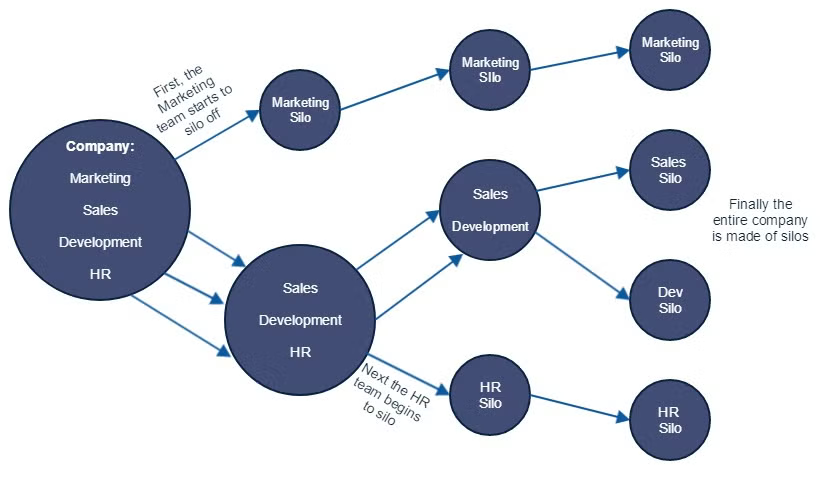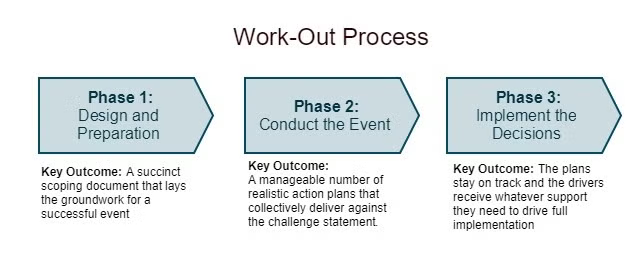Teams of all types and organizations of all sizes need to share information and collaborate in order to succeed. But there are many obstacles to clear communication that can get in the way. One of these main challenges is called silo mentality.
Read on to learn more about organizational silos or jump ahead to one of the following sections:
What is Silo Mentality?
Silo mentality occurs when teams or team members within an organization don't share valuable information or collaborate with one another, leading to difficulties in achieving long-term goals.
As you might have guessed, the name comes from those large, grain-storing metal structures you'll spot on farms. But what about silo mentality in the workplace?
If left unchecked, it will negatively impact even the most profitable company. It's a pitfall that can happen anywhere, regardless of your company's size or structure.
We built Gliffy to help teams share ideas and fight silo mentality — and you can start a free trial to see how easy it is for yourself. Our goal is to get teams out of their silos and onto the same page.
However, while we wish all you needed was a great diagramming tool to break those silos down, there are some additional strategies that go a long way, too.
Along with Gliffy, knowledge management tools like Confluence can help teams share information and collaborate, avoiding the dreaded silo effect. Learn more about Confluence with our resource, What is Confluence Used For?
Back to topWhat Are the Effects of Silo Mentality in the Workplace?
For an organization to be successful, teams or departments have to operate within their own areas of expertise, but they also need to be communicating with one another to move the company forward as a whole. Balancing the need to share information with avoiding information overload is a challenging, but necessary task.
What Does Working in Silos Mean Internally?
A few things tend to happen when employees keep information to themselves:
- There is an increase in inefficiencies and redundancies between departments
- Teams or departments may begin to fight over responsibilities and ownership
- Uncertainty around responsibility and ownership creates a lack of clear accountability
- There is a general sense of unease within the organization's culture
This all ends in the same result, a lack of trust: Departments no longer trust each other to complete their tasks or handle responsibilities. Employee morale takes a dive and people feel isolated and insecure. Individuals feel like their superiors don't care about them, while teams may feel like they're undervalued within the organization as a whole.
When teams stop talking, feedback stops circulating and projects stagnate. Groups in the organization are unable to learn from one another, putting them at risk of losing time and resources while making the same mistakes. Worse, when problems do arise, it's unclear who should handle their resolution or take the initiative to help.
What Does Working in Silos Mean Externally?
Working in silos doesn't just affect your company internally — your customers suffer, too. Redundancies start popping up in the most unexpected places, while other areas are left with gaping holes. Imagine this: you're a video site and a customer is going through your on-boarding process while making an account. They're introduced to the three different features you offer.
- First, they learn how to upload a video — how to title the video, add it to a folder, and so on.
- Second, they learn to create and edit a video with your video editor. They are again shown how to upload the video.
- Last, they learn how to share their video by uploading it and selecting their teammates. They learn how a member of their team can also use the service.
While each step is teaching them something new, they're also learning how to upload a video three times.
This sort of thing happens when teams who don't talk are in charge of different, yet overlapping features. With a disjointed user-facing experience, they've both wasted their user's time as well as their own while creating the redundant tutorials.
This decline in customer experience reflects poorly on both the company and the product. The resulting feedback loop of negativity can cost the company both the morale of its employees and the business of its customers.
Back to topHow do Organizational Silos form?

Silos often happen without anyone noticing because their formation is slow and “natural”. The thing to remember is that the problem is not with the silos themselves, but with the mentality accompanying them.
Silos are more common in large companies because the larger the company, the harder it is to communicate. Silos often start when employees develop a greater sense of loyalty to their individual team or department than that of the organization as a whole. This clique-oriented culture makes collaboration outside core teams more challenging.
That said, silos don't start with teams or individuals — it begins at the top. If management doesn't actively encourage cross-functional and organization-wide learning, they lay the foundation for these silos. When a culture of communication and transparency is fostered by management, it will continue to trickle down to the rest of the organization.
Back to topHow to Stop Silo Mentality from Forming
Silo formation is the result of a lack of communication. To avoid it, teams must focus on continuously improving the way they loop each other in. That’s easier said than done! A culture of communication needs to start from the very top if there is any hope of it becoming part of the foundation of the company.

Breaking Down Silos in Large Companies
There are more issues to solve, more team members involved, and large-scale goals. Creative solutions like forums, cross-functional teams and events, or rotational programs within the company can help connect people across larger organizations.
Additionally, knowledge sharing through channels such as Confluence documentation can help break down silos between departments that struggle to collaborate effectively.
Addressing Silo Mentality in Small Companies
Though it's more common in larger companies (purely because of numbers), silo mentality can happen to anyone. Where size does make a difference, though, is based on how dug into silos you are.
As mentioned before, the deeper in you are and the longer the mentality has been allowed to grow, the more difficult it will be to come out. That's why looking for warning signs and preventing it is the best solution — but that doesn't mean it's impossible to come out of.
Jack Welch, former CEO of GE, championed a “Work-Out” process that has been well-known to help break down silos within a company. The purpose of this process is to help improve collaboration by getting everyone bought in to the solution: breaking down the silos.
Back to topCommunication is the Key to Stopping Silo Formation
At its core, silo mentality in business is caused by a lack of connection and communication. Giving your team the tools it needs to share ideas, explain processes, and address the fact that not everyone has the same types of expertise will help stop silos from forming in your company.
Check out Gliffy’s Confluence and Jira apps as invaluable ways to help your employees embrace that high level of ongoing communication. Check out our visual solutions on the Diagrams for Businesses page or get started with a free trial of Gliffy today.